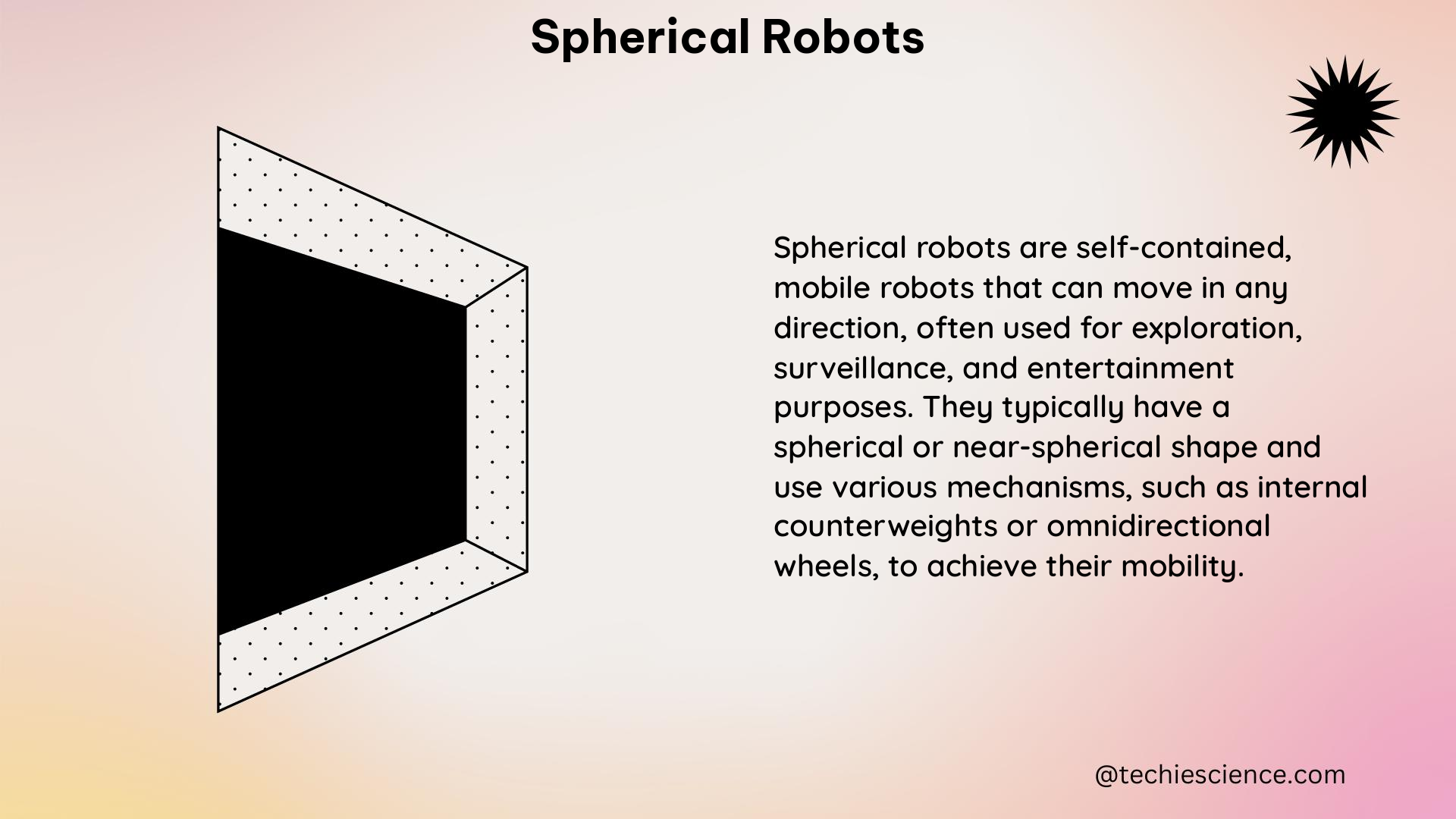Spherical robots are a unique type of mobile robot that have a spherical shape and are equipped with various driving mechanisms and sensors, enabling them to expand their sensing capabilities and perform special purposes, such as underground exploration in mines, tunnels, or other human-made environments.
Driving Mechanisms of Spherical Robots
The driving mechanisms of spherical robots can be categorized into four basic types:
- Single-Wheel Driving Mechanism:
- Consists of a single spherical wheel that rotates around a vertical axis.
- Enables the robot to move in any direction.
- The motion is achieved by controlling the rotation speed and direction of the single spherical wheel.
-
The single-wheel mechanism is simple in design and can provide omnidirectional mobility, but it may have limited maneuverability and stability.
-
Dual-Wheel Driving Mechanism:
- Consists of two spherical wheels that rotate in opposite directions.
- Allows the robot to move forward, backward, and turn around its vertical axis.
- The motion is achieved by controlling the relative speed and direction of the two spherical wheels.
-
The dual-wheel mechanism can provide better maneuverability and stability compared to the single-wheel mechanism, but it may have a larger footprint.
-
Multi-Wheel Driving Mechanism:
- Consists of multiple spherical wheels arranged in a specific pattern.
- Enables the robot to move in any direction.
- The motion is achieved by controlling the speed and direction of the individual spherical wheels.
-
The multi-wheel mechanism can provide enhanced maneuverability and stability, but it may be more complex in design and require more control algorithms.
-
Omnidirectional Driving Mechanism:
- Consists of several spherical wheels that are interconnected and used as wheels for an omnidirectional chassis.
- Allows the robot to move in any direction without changing its orientation.
- The motion is achieved by controlling the speed and direction of the individual spherical wheels.
- The omnidirectional mechanism can provide the highest level of maneuverability and flexibility, but it may be more complex in design and require advanced control algorithms.
Sensors for Spherical Robots

Spherical robots can be equipped with various sensors to expand their sensing capabilities and perform special purposes. Some common sensors used in spherical robots include:
- Inertial Sensors:
- Gyroscopes and accelerometers are used to estimate the attitude and direction of the robot.
- Provide information about the robot’s orientation, angular velocity, and linear acceleration.
-
Crucial for navigation and control of the robot’s movement.
-
Visual Sensors:
- Cameras are used for visual perception and object recognition.
- Enable the robot to detect and identify objects, obstacles, and features in the environment.
-
Can be used for tasks such as mapping, navigation, and object tracking.
-
Laser-based Sensors:
- LiDARs (Light Detection and Ranging) are used for high-resolution 3D mapping and environment perception.
- Provide detailed information about the surrounding environment, including the shape, size, and position of objects.
-
Useful for tasks such as obstacle avoidance, localization, and navigation.
-
Environmental Sensors:
- Thermocouples and gas sensors are used to measure temperature and detect the presence of specific gases.
- Provide information about the environmental conditions, which can be crucial for certain applications, such as underground exploration or hazardous environments.
The combination of these sensors allows spherical robots to perceive their surroundings, navigate through complex environments, and perform specialized tasks with high accuracy and reliability.
Advantages and Applications of Spherical Robots
The unique design and capabilities of spherical robots offer several advantages and potential applications:
- Mobility and Maneuverability:
- The spherical shape and various driving mechanisms provide excellent mobility and maneuverability, allowing the robot to navigate through tight spaces and complex environments.
-
The omnidirectional driving mechanism, in particular, enables the robot to move in any direction without changing its orientation, making it highly versatile.
-
Adaptability to Uneven Terrain:
- The spherical shape and rolling motion of the robot allow it to adapt to uneven or rough terrain, such as underground tunnels, mines, or construction sites.
-
This makes spherical robots suitable for exploration, inspection, and maintenance tasks in challenging environments.
-
Sensor Integration and Versatility:
- The spherical shape and modular design of the robot allow for the integration of various sensors, including cameras, LiDARs, and environmental sensors.
-
This versatility enables spherical robots to perform a wide range of tasks, from mapping and navigation to hazard detection and monitoring.
-
Cost-effectiveness and Safety:
- Spherical robots can be designed and manufactured in a cost-effective manner, making them accessible for various applications.
-
The spherical shape and rolling motion can also contribute to improved safety, as the robot is less likely to cause damage or harm to its surroundings or the humans it interacts with.
-
Underground and Confined Space Exploration:
- The unique capabilities of spherical robots make them well-suited for exploration and inspection tasks in underground environments, such as mines, tunnels, and pipelines.
-
Their ability to navigate through tight spaces and adapt to uneven terrain is particularly valuable in these applications.
-
Hazardous Environment Monitoring:
- Spherical robots can be equipped with sensors to detect and monitor various environmental conditions, such as temperature, gas levels, and radiation.
-
This makes them useful for tasks in hazardous or inaccessible environments, where human presence may be unsafe or impractical.
-
Mobile Mapping and Surveying:
- The combination of sensors, such as cameras and LiDARs, on spherical robots can be leveraged for mobile mapping and surveying applications in human-made environments.
- The robot’s ability to navigate through complex spaces and capture detailed 3D data can contribute to efficient and comprehensive mapping and surveying tasks.
These advantages and applications demonstrate the potential of spherical robots to revolutionize various industries and fields, from underground exploration to hazardous environment monitoring and mobile mapping.
Challenges and Future Developments
While spherical robots offer numerous advantages, there are also some challenges and areas for future development:
- Control and Stability:
- Controlling the motion and stability of spherical robots can be complex, especially when dealing with uneven terrain or dynamic environments.
-
Advancements in control algorithms and sensor fusion techniques are necessary to improve the robot’s stability and maneuverability.
-
Energy Efficiency and Autonomy:
- Improving the energy efficiency and battery life of spherical robots is crucial for extended operation and autonomous missions.
-
Developments in power management systems, energy-efficient actuators, and advanced battery technologies can contribute to enhanced autonomy.
-
Robustness and Reliability:
- Ensuring the robustness and reliability of spherical robots is essential for their deployment in real-world applications, especially in harsh or unpredictable environments.
-
Improving the mechanical design, material selection, and fault-tolerance mechanisms can enhance the overall reliability of these robots.
-
Sensor Integration and Data Processing:
- Integrating a diverse range of sensors and effectively processing the acquired data is a key challenge for spherical robots.
-
Advancements in sensor fusion algorithms, edge computing, and data analysis techniques can enable more efficient and intelligent decision-making.
-
Collaborative and Swarm Capabilities:
- Exploring the potential of spherical robots to work collaboratively or in swarms can unlock new applications and enhance their capabilities.
-
Developing coordination algorithms and communication protocols for multi-robot systems can lead to more versatile and scalable solutions.
-
Standardization and Regulations:
- Establishing industry standards and regulatory frameworks for the design, safety, and operation of spherical robots can facilitate their widespread adoption and integration into various sectors.
As research and development in the field of spherical robots continue, these challenges and areas for improvement will be addressed, paving the way for more advanced, reliable, and versatile spherical robot systems that can revolutionize various industries and applications.
Conclusion
Spherical robots are a unique and promising type of mobile robot that offer exceptional mobility, maneuverability, and versatility. Their spherical shape, combined with various driving mechanisms and sensor integration, make them well-suited for specialized tasks in challenging environments, such as underground exploration, hazardous environment monitoring, and mobile mapping.
While spherical robots have already demonstrated their potential, there are ongoing efforts to address the challenges related to control, energy efficiency, robustness, and sensor integration. As research and development in this field continue, we can expect to see more advanced and capable spherical robot systems that can unlock new applications and revolutionize various industries.
References
- Fabian Arzberger, Anton Bredenbeck, Jasper Zevering, Dorit Borrmann, and Andreas Nüchter. Towards spherical robots for mobile mapping in human made environments. 10/01/2021.
- Marek Bujňák, Rastislav Pirník, Karol Rástočný, et al. Spherical Robots for Special Purposes: A Review on Current Possibilities. 2022-02-12.
- Enzo Wälchli. How do you measure the value of robotics projects for clients? 2023-08-21.

I have a background in Aerospace Engineering, currently working towards the application of Robotics in the Defense and the Space Science Industry. I am a continuous learner and my passion for creative arts keeps me inclined towards designing novel engineering concepts.
With robots substituting almost all human actions in the future, I like to bring to my readers the foundational aspects of the subject in an easy yet informative manner. I also like to keep updated with the advancements in the aerospace industry simultaneously.